Toys
Toy Hitler
A popular toy in Nazi Germany was a miniature model of Hitler. It came in six action poses, including Hitler in an army jeep and in an open car doing the Nazi salute.Not many of these toy Hitlers survive, so if you have one, for some reason, it's probably worth some money. One of them was featured on Antiques Roadshow in 2012.

Newsweek - Dec 26, 1938

Posted By: Alex - Wed Dec 16, 2020 -
Comments (5)
Category: Dictators, Tyrants and Other Harsh Rulers, Toys, 1930s
Farrah’s Glamour Center
Part of the 'Farrah mania' of the late '70s.In 2011, it became part of the Smithsonian's popular culture history collection.

Posted By: Alex - Fri Nov 27, 2020 -
Comments (0)
Category: Celebrities, Toys, 1970s
Diaper-Rash Doll

Jackson Sun - Oct 11, 1978
Posted By: Alex - Sat Sep 19, 2020 -
Comments (0)
Category: Toys, 1970s
Digital Rubik’s Cube
A toy that seemed utterly immune to becoming digital...was not.Review and details here.

Posted By: Paul - Sun Jul 12, 2020 -
Comments (3)
Category: Excess, Overkill, Hyperbole and Too Much Is Not Enough, Technology, Toys
Mold-A-Rama
Wikipedia page.
Posted By: Paul - Sat Apr 11, 2020 -
Comments (1)
Category: Eccentrics, Collectors, Inventions, Souvenirs, Mementos, and Tchotchkes, Toys, Statues and Monuments, 1960s
Three-Faced Doll
Introduced in 1961, her name was "Hedda-Get-Bedda." Twisting a knob changed her face from sick, to well, to sleepy.I'm surprised no one ever came out with a similar, Exorcist-themed doll. She could have been happy, sleeping, or demonically possessed.

Allentown Morning Call - Sep 29, 1961
Posted By: Alex - Sat Apr 04, 2020 -
Comments (2)
Category: Toys, 1960s
Suntan Suzy Doll
Suntan Suzy was a doll that would develop a tan if you put her in the sunlight. Back in the shade, her tan would fade. She came on the market in 1962, but lasted only one season. As far as I can tell, she was the only doll that has ever had the ability to tan.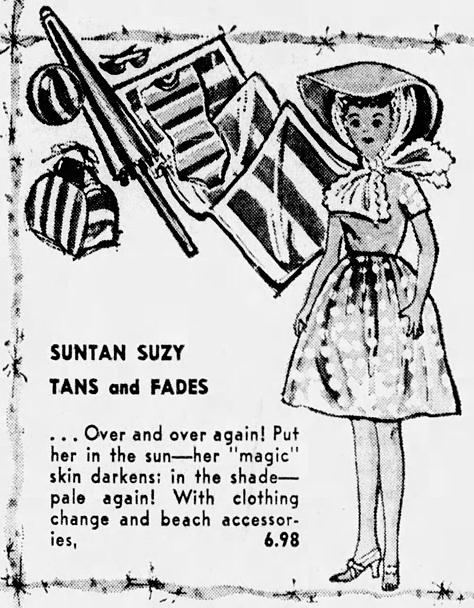
Arizona Republic - Nov 23, 1962
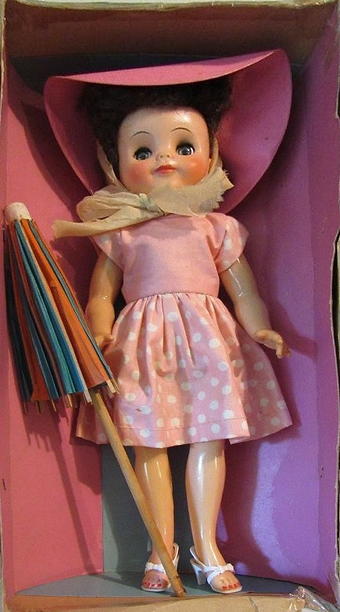
image source: worthpoint
The chemistry responsible for producing the tanning effect is described in Patent No. 2,921,407 (Jan 19, 1960) – “Simulating Sunburning Toy Dolls and Figurines”:

1550 grams of a high molecular weight polyvinyl chloride polymer, in powdered form, were dispersed in this solution by stirring for ten to fifteen minutes. The latter material was specifically Bakelite Company QYNV polymer. Thus a plastisol formulation containing the phototropic dye dissolved in the liquid dioctyl phthalate (plasticizer phase) was obtained. About 120 grams of this plastisol formulation were then poured into a two piece steel mold, this having its inner surface previously coated with a silicone oil release film. This was then placed in an oven at 140 degrees centigrade and held at this temperature for eight minutes to allow solution of the polyvinyl chloride polymer phase. The mold and contents were then removed from the oven, cooled to room temperature, and the now solid form of the doll figure removed.
The figure thus produced was transparent and red in color. Upon exposure to sunlight a progressive darkening to a brown, then blue-black color occurred during a period of about three to four minutes, simulating a “sunburning” effect. When the doll was shielded from the sun a return to the original color took place, being visually complete after a period of eight to ten minutes. This action was repeatable with no detectable change in functional characteristics being noted after several dozen cycles.
It seems like an interesting gimmick for a doll. Curious it never caught on.
Posted By: Alex - Fri Feb 07, 2020 -
Comments (3)
Category: Inventions, Patents, Toys, 1960s
Fly-Operated Turtle
Patent No. 1,591,905, granted to Oscar C. Williams of San Diego, CA in 1926, described this curious device.It was a toy turtle. Its body was made of wood or aluminum, while the head, legs, and tail were made from lightweight cork. The user was supposed to insert several flies into the hollow body of the turtle. Their agitations once inside, as they sought to escape, would then cause the movable parts of the turtle to wag from side to side, as if the creature was alive.
I can see several drawbacks. First, you would have to catch some flies and maneuver them (alive) into the turtle. This was done by squeezing them through the leg hole. Handling a fly in this way seems like it could be a challenge.
And once in there, I imagine you'd have to wait until the flies died to get them back out. So, essentially, it was a fly torture device.

Posted By: Alex - Sun Dec 22, 2019 -
Comments (4)
Category: Insects and Spiders, Inventions, Patents, Toys, 1920s
The Gay Bob Doll
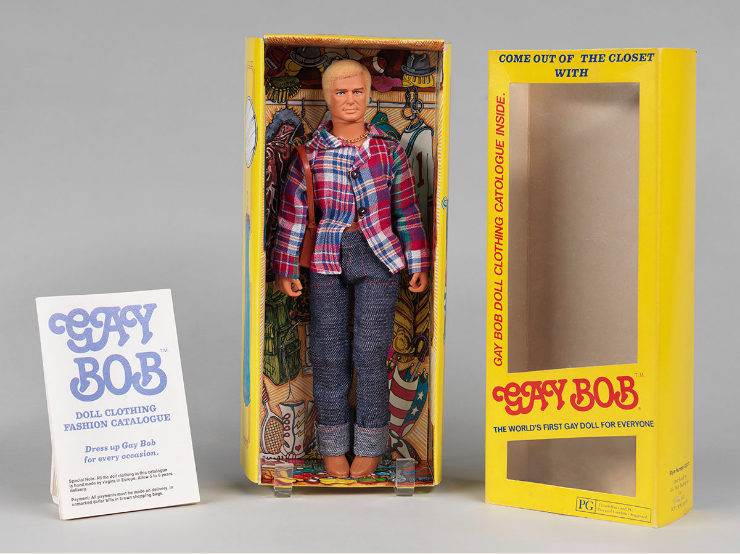
Read the whole story here.
Posted By: Paul - Sun Dec 22, 2019 -
Comments (2)
Category: Toys, 1970s, LGBT
Thuggies Dolls
Introduced in 1993, Thuggies were dolls that came with a "rap sheet". As described in the Philadelphia Daily News (Feb 3, 1993):Each comes packaged in a cardboard “jail cell” with a “rap sheet” describing his or her crime — and the penalty being paid. For instance, “Bonnie Ann Bribe” is said to be serving time by reading to senior citizens an hour a day. Bonnie, who did not read in first grade, wanted to bribe her way through school. “Dwight Collared Grimes,” who wears a pin-striped suit and a tie and, according to his rap sheet, used to have his hand in other people’s cookie jars, is said to be “presently on cookie-baking duty.”
According to Clark, the positive effect of cuddling these criminals comes from the notion that the doll’s young owner plays a role in “reforming” them. She explained that the dolls, expected to cost about $35 each, have a report card that explains what they have to do to go straight.
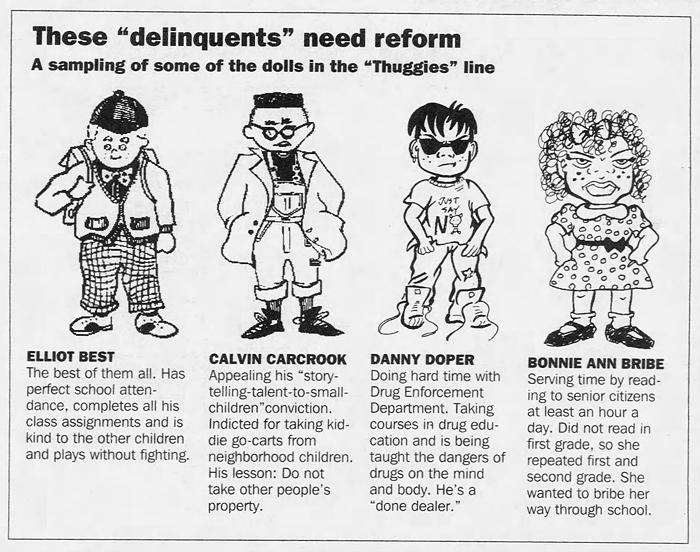
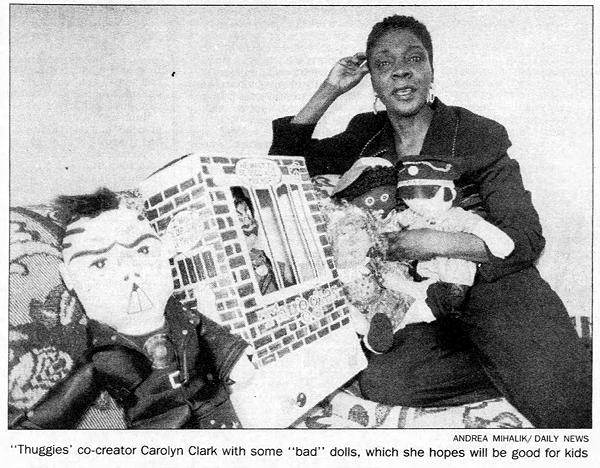
Posted By: Alex - Tue Dec 17, 2019 -
Comments (2)
Category: Toys, 1990s

| Who We Are |
|---|
| Alex Boese Alex is the creator and curator of the Museum of Hoaxes. He's also the author of various weird, non-fiction, science-themed books such as Elephants on Acid and Psychedelic Apes. Paul Di Filippo Paul has been paid to put weird ideas into fictional form for over thirty years, in his career as a noted science fiction writer. He has recently begun blogging on many curious topics with three fellow writers at The Inferior 4+1. Contact Us |




